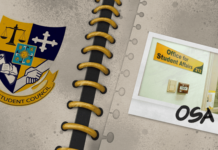CAMPUS academic leaders welcomed the news that Asiaweek has stopped its controversial annual survey of Asia’s top universities.
“There are variables in the survey that would be unfair to UST and other schools,” UST Secretary-General Fr. Rodel Aligan, O.P. said. “That could be the reason they discontinued it.”
The discontinuance of the survey was reported by the Philippine Collegian, official student publication of the University of the Philippines, last June 26. The paper had e-mailed Asiaweek to ask for the results of this year’s survey, but the magazine said it had been stopped “for editorial reasons.”
Last year, Philippine universities registered a marked decline in the survey. UP was no. 48 in overall ranking (53.79%), dropping from its 32nd place (53.80%) in 1999. Meanwhile, De La Salle University (DLSU), Ateneo de Manila University (AdMU), and UST were clustered at the bottom ranks of 71st, 72nd, and 74th respectively.
The measure
The survey started in 1997 with 50 multi-disciplinary schools participating in the listing. The number grew the following year with 95 universities.
On its third year, the survey assessed 114 multi-disciplinary and science and technology schools in the region based on faculty resources, research output, student-per-teacher ratio, and Internet access.
For its year 2000 survey, the weight on academic reputation remained at 20 percent, the weight based on the rating (from one to five scale, five being the highest) given by the university’s peers. Thirty Asian corporations and 11 foreign universities also gave their ratings.
Twenty-five (25) percent went to student selectivity, derived from the total number of first year applicants versus the number of accepted applicants, and their median score in national or university test.
Another 25 percent went to faculty resources, derived from full-time teachers/researchers with master’s and doctorate (PhD) degrees, median pay, per-teacher university spending, and student-teacher ratio.
Twenty (20) percent went to research, computed from citation in academic journals as tracked by the Journal Citation Index (JCI), articles in peer reviewed journals, papers presented in international conferences, published books, research funding, and graduate student-researchers.
A weight of 10 percent went to financial resources derived from total spending per student, library spending per student, Internet bandwidth, and public computers and connection points.
A sixth criterion, laboratory spending, was added for science and technology schools.
Flawed method
The fact that the survey has been stopped has been taken as an admission the survey’s method is flawed.
There have been questions on the methodology used by the magazine in ranking universities in the Asia-Pacific region. This, and other cited defects of the survey were the reasons the 1997 and 1998 topnotcher, University of Tokyo, withdrew in 1999.
Hasumi Shigehiko, president of the 121-year old Japanese university, said in a letter to Asiaweek in 1999 that “the quality (of our) education and research can not be compared with that of other universities.”
Hasumi added, “Such characteristics (survey’s criteria) are profoundly individual and extremely difficult to quantify.”
Fr. Aligan and other Philippine educators criticized the survey for its heavy emphasis on “financial resources.”
In the 1997 survey, it was stressed that “financial resources can help buy excellence,” citing universities with cheapest fees, underpaid professors, and inadequate and poor facilities as reasons majority of participating institutions, particularly in Southeast Asia ranked lower.
Emphasis on the university’s budget was the main point why UP ranked only 67th in financial resources category. De La Salle and Ateneo rated higher on this criterion because of higher per capita spending as well as bigger Internet bandwidths and students’ and faculty’s access to public computers.
Meanwhile, another loophole was the unfixed or annually changed weight given to an item, thus, preventing the participants to come up with a definitive evaluation of their performance.
In 1997, the survey gave a 15 percent weight on financial resources. The following year, Asiaweek reduced it to 10 percent and replaced the value-for-added-money (computed by the averaged tuition and other fees collected from each student, and the difference between per-student college spending and per-student tuition fees) with research output category, which made up the remaining 20 percent of the final grade.
The proposals and complaints of participating and non-participating universities could be the reasons the magazine shelved its listing for this year.
Fr. Aligan said the survey’s discontinuation did not create any impact on UST since the University is founded on solid grounds.
“I don’t see any impact at all. Here, we are known as one of the best schools, along with UP, Ateneo, and De La Salle,” he said.
UP president Francisco Nemenzo said in the Collegian that the survey’s emphasis on money resources explains why the state university ranks low in this criterion. UP cannot compete with its foreign counterparts in terms of financial resources because of its meager budget.
Welcome move
Rector Fr. Tamerlane Lana, O.P. said that Asiaweek should not conduct the survey annually but periodically to give time to participating schools to evaluate their performance.
“You cannot tell if there is a substantial change in the institution or not (based on the annual survey) because one year of evaluation is not enough,” Lana explained.
He added that UST had wanted the survey conducted every three years. He welcomed the discontinuation as a good step because this would help the participating schools to upgrade its standards.
Fr. Lana also cited Far Eastern University’s (FEU) suggestion to ask Asiaweek to ratify its criteria.
“Even though FEU is not among those considered as one of the best universities, still, they are suggesting that we (should) do something to ratify the criteria being used because, they seem to be not applicable to all universities,” he said. Ma. Lynda C. Corpuz with reports from Bernardette S. Sto. Domingo










